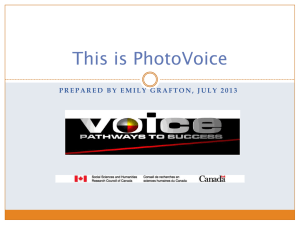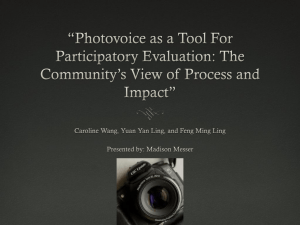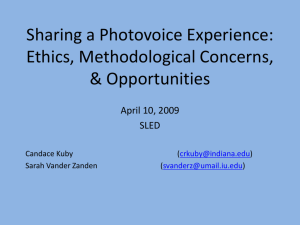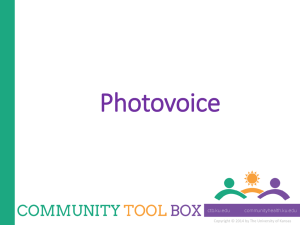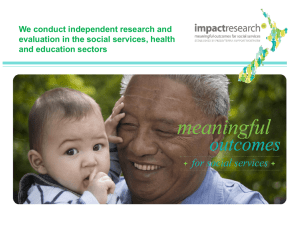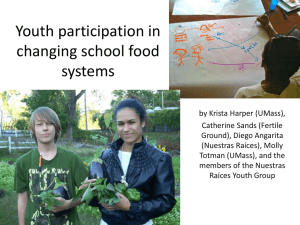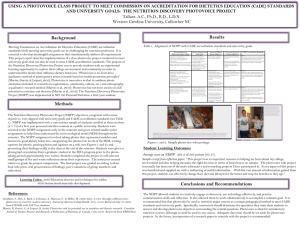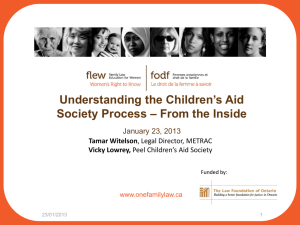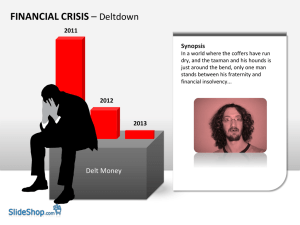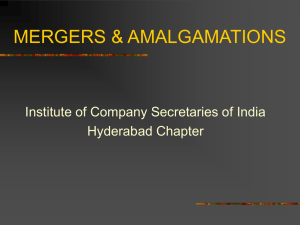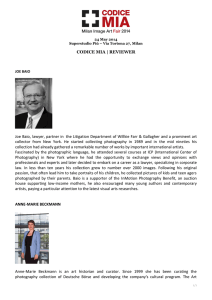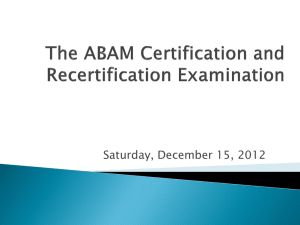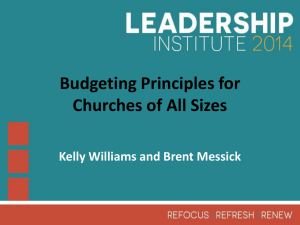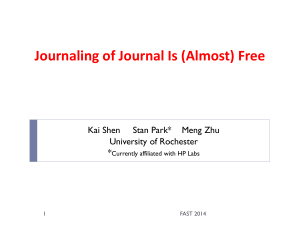TC3 - Photovoice - A New Hope - Addictions and Mental Health
advertisement
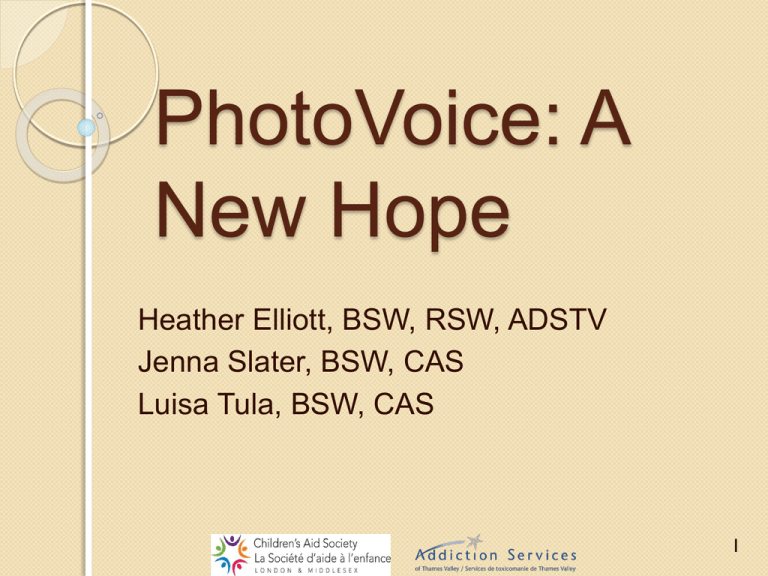
PhotoVoice: A New Hope Heather Elliott, BSW, RSW, ADSTV Jenna Slater, BSW, CAS Luisa Tula, BSW, CAS 1 Agenda PhotoVoice background Stage-based Treatment Why Use Creative Arts PhotoVoice: A New Hope Benefits of Working in Collaboration The Next PhotoVoice Creating a PhotoVoice Group 2 “Standing in the dark” “One of the biggest changes for me was letting go of the unhealthy people in my life. I am like this flower, surrounded by others but out on my own. I feel that I am alone standing in the dark, but I know when I am ready I will welcome the right people into my life.” 3 PhotoVoice: Background Photovoice essays are a documentary style of photography using participatory action research methods. First developed in 1990s by Caroline Wang, University of Michigan. created "Photo Novella," what is now known as Photovoice, as a way to enable rural women of Yunnan Province, China, to influence the policies and programs that affected them. 4 As Carolyn Wang says: “Photovoice blends a grassroots approach to photography and social action. It provides cameras not to health specialists, policy makers, or professionals, but to people with least access to those who make decisions affecting their lives…” “Photovoice is a process by which people can identify, represent, and enhance their community through a specific photographic technique. It entrusts cameras to the hands of people to enable them to act as recorders, and potential catalysts for social action and change, in their own communities. It uses the immediacy of the visual image and accompanying stories to furnish evidence and to promote an effective, participatory means of sharing expertise to create healthful public policy.” 5 PhotoVoice: Background Designed to empower traditional subjects of documentary photography to educate themselves, the general public, and policy makers about identified issues. By providing cameras to a marginalized population without a voice in society, they are able express themselves through photography, empowering them to share their thoughts and feelings about community issues, reduce social isolation and vulnerability 6 “Footprints in the sand” “This represents my future and my journey. It reminds me of the poem Footprints in the sand. Addiction brings you down. I felt alone and my life sucked, but now I know that I was not alone, even if I didn't always feel it at the time. There were always signs of life around me.” 7 Stages of Change Paradigm – Prochaska and DiClemente Model well tested; used all over the world; portable Has created a paradigm shift How to understand behaviour change How to influence behaviour change New framework to work with Based on research with selfchangers 8 Stages of Change Introduction to Six Stages: ◦ ◦ ◦ ◦ ◦ ◦ Pre-contemplation Contemplation Preparation Action Maintenance Termination Relapse ◦ Re-engagement with problem behaviour 9 “Walking Spirits” “This picture represents the people in my life who protect me and help keep me safe. It helps me to remember the people I have lost over the years and to know that they are still with me in spirit.” 10 What is Stage-based Treatment Addiction treatment that is designed specifically for individuals at various stages of change Increases effectiveness of treatment when all group participants are in the same/ similar stage of change 11 PhotoVoice: Maintenance Stage of Change PhotoVoice: A New Hope was specifically designed for women in the maintenance stage of change Created to help them focus on what gives them hope in recovery Help to convey hope to others as well Stability required due to some locations of the outings for the pictures 12 “The first few steps were the hardest” “Being at the bottom is like being messed upgoing through recovery is not easy, it's challenging. The first few steps were the hardest and then it got easier. At the top I achieved freedom and having my son back. You can't always see what's at the top.” 13 PhotoVoice: A New Hope WHY USE CREATIVE ARTS FOR ADDICTION TREATMENT? 14 Stigmatized individuals are given a “voice” to share their experiences Individuals who are stigmatized in society are given a “voice” to share their experiences for the purpose of educating the general population, including policy makers. The identified population are often the “subjects” of photographs The participants create the artistic images and the accompanying messages, assisting them to gain control over their own perceptions of their surroundings 15 Creating a theme… Allows the photographer to examine and visually express thoughts and feelings Helps the artist to internalize the message The literature shows that people who reflect on a subject begin to internalize its message. Examining the idea of hope can serve as a vehicle to acquiring hope 16 Photo therapy… Complements traditional therapies in improving self-esteem, and overall quality of life Studies have found that engaging marginalized peoples in artistic programs increased confidence, self-esteem and skill development Noted that participants benefited in many other ways from participation in communitybased arts projects, including making new friends, trying something new, feeling success, being creative, changing ideas, and learning about other people 17 “Messed Up” “This picture reminds me of being messed up, out of control. However, I feel hope when I look at it. I can see my hands and it feels like I am reaching out, waiting for somebody to take my hands and help me, to pull me out.” 18 PhotoVoice: A New Hope PhotoVoice: A New Hope is a journey with women who are walking through recovery, focusing on aspects of hope within their lives. The theme of hope is depicted through pictures taken by the women and through narratives that explain the significance of these photos. The goal of the project is not only to focus on the individual women, but also to create a forum to educate others about addiction and recovery. It is meant to increase public understanding, minimize shame, and increase compassion. 19 The Women of PhotoVoice All mothers Long history of substance abuse Extensive involvement with CAS Poverty Trauma histories Maintenance stage of change with both abstinence and harm reduction Current clients with ADSTV or CAS 20 PhotoVoice: A New Hope Partnership with CAS London-Middlesex and ADSTV Facilitated by 2 Child Protection Workers and 1 Addiction/ Mental Health Counsellor 8 week group Pre/ post tests Participants taught basic photography skills & given a digital camera 3 outings to take pictures as a group Journaling of meaning of picture related to the theme of hope in recovery 21 Pre/ Post Test Perceived Social Supports Drug Taking Confidence Questionnaire – Alcohol and Drugs All had an increase in PSS for both family and friends Confidence level remained the same or increased, except one woman Increase in hope for all women Trait Hope Scale 22 Group Outline – Week One Review of how the program was developed Review of Photo Voice Establish group norms and expectations Review Rights of Photographers and potential copyright issues Signing of consents and releases Completed pre-test tools Women given their cameras & taught basic functions 23 Group Outline – Week Two Check-in Discussion ◦ How do you define hope? ◦ Discuss how hope would look as a photograph Review of general camera use to address any questions Taught basic photography techniques Review of women’s pictures 24 Group Outline – Week Three Field Trip - Port Stanley CAS provided transportation to the participants and facilitators for the field trip Women were provided with suggestions on what to photograph Lunch was provided Review of women’s pictures 25 Group Outline – Week Four Field trip downtown Participants and facilitators met at ADSTV and walked downtown Focus is to re-write their story given that downtown may hold negative memories for some of the participants De-briefing of the women after the outing Review of women’s pictures 26 Group Outline – Week Five Field trip to Springbank Park CAS provided transportation to the participants and facilitators for the field trip Further discussion about their journey and the meaning of hope Women provided with one to one support Picnic lunch 27 Group Outline – Week Six Women begin to select their pictures and begin to critique - discussion encouraged in regards to their pictures and their meanings Pictures downloaded onto two laptops to help with editing - select pictures for the final showing Give helpful advice Volunteer support to assist with editing and journalling 28 Group Outline – Weeks Seven and Eight Focusing on preparing for the display matting their photos and completing any outstanding journaling Completed post-test tools and conduct group evaluation Project termination and wrap-up Pizza lunch provided during week eight as part of wrap-up celebration 29 The Exhibit Held at Kings University College One night, two hours Facilitators set-up display for women Women attended and brought family and friends Event was advertised, open to community Copies of pictures were sold along with note cards 30 Additional Showcasing CAS of London and Middlesex has designated a specific area within the building in which to display the Photo Voice photos (for both current and future groups) The Photo Voice project was also invited to King’s University College during Social Work week to display the photos ADSTV promoted and displayed pictures at its AGM and annual Recovery Breakfast 31 Proceeds from the Sales 60% of proceeds from each woman’s pictures were given to her 40% re-invested into the program so it could run again Prices of pictures varied based on size of picture being ordered Lots of note cards sold however, no real proceeds gained due to cost of printing 32 “I am broken” “This bridge represents my life when I was using. I was broken, my heart was broken. I felt like two separate people. A mother and an addict struggling with so many hurts. I didn’t think it would ever be possible to heal, to be whole again.” 33 Why did CAS & ADSTV Partner? Began partnership with having CAS staff co-facilitate treatment groups Goal to help cross train CAS and ADSTV to better understand each others roles with clients Help to demonstrate collaborative relationship to clients Increase support available to clients through increased shared programming 34 Mutual benefits of Collaboration (CAS and Addiction Services) Occurred on several levels: Resources maximized (synergize) Gap in the community addressed Women observe agency staff working together for their benefit Staff and clients are educated at the same time Staff satisfaction Other partnerships get launched 35 Benefits of Collaboratively Using Creative Arts Projects in Treatment Participants were able to develop positive relationships with the Children’s Aid Society Participants were able to offer each other support and encouragement Participants were able to engage in an activity that was positive and they were able to develop new skills Participant were able to observe the collaboration between two agencies 36 Benefits of Collaboratively Using Creative Arts Projects in Treatment For staff, this type of project offers variety and excitement to complement everyday work responsibilities Participants were able to have one-onone time with counsellors, discussing their journey and the gains they have made Participants were given digital cameras which could be used to take pictures of family and friends 37 Drawbacks Participants struggled with the concept of hope- very abstract and facilitators needed to spend more time discussing this concept Potential conflict between participants to due previous history/affiliation Participants not completing the group Extenuating circumstances which impact participant’s ability to take photos or attend the outings 38 “Fearless” “I use to be scared to get on the bus, paranoid of people looking at me, ashamed of what I looked like, feeling that I did not fit in. I don’t have that fear anymore. Now I ride the bus all the time.” 39 What’s Next for PhotoVoice? New group started May 24, 2011 8 women registered to participate Increased demand to join group Theme – “Then & Now” Maintenance stage of change 5 weeks, 2 outings, 2 weeks for journaling and matting pictures, 1 Exhibit 40 “Life has stains and rough patches” “Life has stains and rough patches, but it all fits together. Each person has a different history and layers, much like the bricks in this wall. Each brick has been impacted by different circumstances.” 41 Creating Your PhotoVoice Determine budget Select target client population Set length of group (number of weeks and length of each session) Choose locations for outings & group Identify number of group facilitators needed Plan for the exhibit 42 Pre-Group Preparation Research and development of project Acquire a safe and comfortable space for programming Potential participant screening for commitment and stage of change Creation of consent forms and handouts Purchase of supplies Select pre/ post assessment tools 43 Determining a Budget Consider: ◦ ◦ ◦ ◦ ◦ ◦ ◦ ◦ Cost of cameras Memory cards Batteries Printing pictures, mattes, exhibit expenses Bus tickets/ transportation support Snacks/ meals for outings Child care Facilitator salary 44 Target Population Gender specific vs. co-ed Age range – target specific group or leave open Common experiences i.e. consider addictions, child welfare involvement, poverty, homeless, mental health Reflect on potential group dynamic issues that may arise due to population 45 Length of Group Determine number of sessions How long should each session be Amount of time needed may vary based on location of outings chosen Leave adequate to review and process pictures taken Provide increased support for journaling, editing and matting of photos 46 Locations for Outings Places participants are familiar with Places participants can’t often go to on their own What is the theme of the group Tie location selection to supporting theme and meaning of the group Consider what might be triggering vs. opportunity to reframe past experience 47 Facilitation Participant to facilitator ratio may vary based on planned activities for group Do you want to teach any basic photography skills Who will complete editing of pictures Support for picture selection and completing journals – consider literacy issues 48 The Exhibit Location accessible to participants but also appealing to community Advertise in advance – especially that pictures will be for sale Consider the role of group participants Will food be offered during event How to coordinate ordering of pictures Comfort level of participants to be identified during the exhibit 49 “Finding Faith” “I remember the day I decided I had had enough. I prayed to God to help me, to give me a sign and he did. Throughout my recovery, rediscovering my spiritual life as been critical. This cross helps to give me hope to believe, to stay focused.” 50 Questions or Comments? Thank-you for your attention! 51 Helpful Websites www.adstv.on.ca www.ccsa.ca www.camh.net www.breakingthecycle.ca www.jeantweed.com www.motherisk.org www.streetdrugs.org www.aadac.com www.motivationalinterview.org www.bccewh.bc.ca www.dart.on.ca www.seekingsafety.org www.photovoice.org www.photovoice.ca 52
